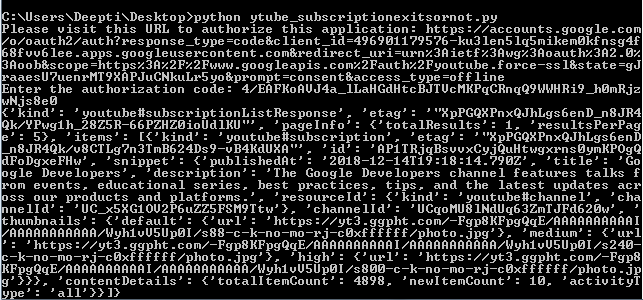先决条件:Youtube Data API 订阅 |组 1
现在我们将讨论剩余的两种列出订阅的方法,即列出授权用户帐户的订阅和检查订阅是否存在。
列出授权用户帐户订阅的代码:
此示例显示如何检索与自己的帐户关联的订阅列表。
注意:此方法强制需要用户授权。
import os
import google.oauth2.credentials
import google_auth_oauthlib.flow
from googleapiclient.discovery import build
from googleapiclient.errors import HttpError
from google_auth_oauthlib.flow import InstalledAppFlow
# The CLIENT_SECRETS_FILE variable specifies
# the name of a file that contains
# client_id and client_secret.
CLIENT_SECRETS_FILE = "client_secret.json"
# This scope allows for full read/write access
# to the authenticated user's account and requires
# requests to use an SSL connection.
SCOPES = ['https://www.googleapis.com/ auth/youtube.force-ssl']
API_SERVICE_NAME = 'youtube'
API_VERSION = 'v3'
def get_authenticated_service():
flow = InstalledAppFlow.from_client_secrets_file(CLIENT_SECRETS_FILE, SCOPES)
credentials = flow.run_console()
return build(API_SERVICE_NAME, API_VERSION, credentials = credentials)
def print_response(response):
print(response)
# Build a resource based on a list of
# properties given as key-value pairs.
# Leave properties with empty values
# out of the inserted resource.
def build_resource(properties):
resource = {}
for p in properties:
# Given a key like "snippet.title", split into
# "snippet" and "title", where "snippet" will be
# an object and "title" will be a property in that object.
prop_array = p.split('.')
ref = resource
for pa in range(0, len(prop_array)):
is_array = False
key = prop_array[pa]
# For properties that have array values, convert a name like
# "snippet.tags[]" to snippet.tags, and set a flag to handle
# the value as an array.
if key[-2:] == '[]':
key = key[0:len(key)-2:]
is_array = True
if pa == (len(prop_array) - 1):
# Leave properties without values out of inserted resource.
if properties[p]:
if is_array:
ref[key] = properties[p].split(', ')
else:
ref[key] = properties[p]
elif key not in ref:
# For example, the property is "snippet.title",
# but the resource does not yet have a "snippet"
# object. Create the snippet object here.
# Setting "ref = ref[key]" means that in the next
# time through the "for pa in range ..." loop,
# we will be setting a property in the
# resource's "snippet" object.
ref[key] = {}
ref = ref[key]
else:
# For example, the property is "snippet.description",
# and the resource already has a "snippet" object.
ref = ref[key]
return resource
# Remove keyword arguments that are not set
def remove_empty_kwargs(**kwargs):
good_kwargs = {}
if kwargs is not None:
for key, value in kwargs.items():
if value:
good_kwargs[key] = value
return good_kwargs
def subscriptions_list_my_subscriptions(client, **kwargs):
kwargs = remove_empty_kwargs(**kwargs)
response = client.subscriptions().list(**kwargs).execute()
return print_response(response)
if __name__ == '__main__':
# When running locally, disable OAuthlib's
# HTTPs verification. When running in production
# * do not * leave this option enabled.
os.environ['OAUTHLIB_INSECURE_TRANSPORT'] = '1'
client = get_authenticated_service()
subscriptions_list_my_subscriptions(client,
part ='snippet, contentDetails',
mine = True,
maxResults = 2)
输出:
在执行代码时,您将被要求提供授权代码。要获取代码,您需要按照以下行上方的命令提示符屏幕中提到的链接进行操作:输入授权代码。
现在点击链接并复制粘贴您将通过授予权限获得的授权代码。
我们已将 mine 属性设置为 True 值。从输出中可以清楚地看出有 38 个订阅,并且由于我已将 maxResults 属性声明为 2,因此它仅显示 2 个结果。 
检查订阅是否存在的代码:
此示例显示订阅是否存在。此示例显示授权用户是否订阅由forChannelId参数标识的频道。要检查另一个频道是否订阅了forChannelId参数中指定的频道,请删除我的参数并将其替换为 channelId 参数。:
import os
import google.oauth2.credentials
import google_auth_oauthlib.flow
from googleapiclient.discovery import build
from googleapiclient.errors import HttpError
from google_auth_oauthlib.flow import InstalledAppFlow
# The CLIENT_SECRETS_FILE variable specifies
# the name of a file that contains
# client_id and client_secret.
CLIENT_SECRETS_FILE = "client_secret.json"
# This scope allows for full read/write access
# to the authenticated user's account and
# requires requests to use an SSL connection.
SCOPES = ['https://www.googleapis.com/auth/youtube.force-ssl']
API_SERVICE_NAME = 'youtube'
API_VERSION = 'v3'
def get_authenticated_service():
flow = InstalledAppFlow.from_client_secrets_file(CLIENT_SECRETS_FILE, SCOPES)
credentials = flow.run_console()
return build(API_SERVICE_NAME, API_VERSION, credentials = credentials)
def print_response(response):
print(response)
# Build a resource based on a list of properties
# given as key-value pairs. Leave properties with
# empty values out of the inserted resource.
def build_resource(properties):
resource = {}
for p in properties:
# Given a key like "snippet.title", split into
# "snippet" and "title", where "snippet" will be
# an object and "title" will be a property in that object.
prop_array = p.split('.')
ref = resource
for pa in range(0, len(prop_array)):
is_array = False
key = prop_array[pa]
# For properties that have array values, convert a name like
# "snippet.tags[]" to snippet.tags, and set a flag to handle
# the value as an array.
if key[-2:] == '[]':
key = key[0:len(key)-2:]
is_array = True
if pa == (len(prop_array) - 1):
# Leave properties without values out of inserted resource.
if properties[p]:
if is_array:
ref[key] = properties[p].split(', ')
else:
ref[key] = properties[p]
elif key not in ref:
# For example, the property is "snippet.title", but the resource does
# not yet have a "snippet" object. Create the snippet object here.
# Setting "ref = ref[key]" means that in the next time through the
# "for pa in range ..." loop, we will be setting a property in the
# resource's "snippet" object.
ref[key] = {}
ref = ref[key]
else:
# For example, the property is "snippet.description",
# and the resource already has a "snippet" object.
ref = ref[key]
return resource
# Remove keyword arguments that are not set
def remove_empty_kwargs(**kwargs):
good_kwargs = {}
if kwargs is not None:
for key, value in kwargs.items():
if value:
good_kwargs[key] = value
return good_kwargs
def subscriptions_list_for_channel_id(client, **kwargs):
kwargs = remove_empty_kwargs(**kwargs)
response = client.subscriptions().list(**kwargs).execute()
return print_response(response)
if __name__ == '__main__':
# When running locally, disable OAuthlib's HTTPs verification.
# When running in production * do not * leave this option enabled.
os.environ['OAUTHLIB_INSECURE_TRANSPORT'] = '1'
client = get_authenticated_service()
subscriptions_list_for_channel_id(client,
part ='snippet, contentDetails',
forChannelId ='UC_x5XG1OV2P6uZZ5FSM9Ttw',
mine = True)
输出:
在执行代码时,您将被要求提供授权代码。要获取代码,您需要按照以下行上方的命令提示符屏幕中提到的链接进行操作:输入授权代码。 
现在点击链接并复制粘贴您将通过授予权限获得的授权代码。 

由于 totalResults 参数的值为 1,这意味着授权用户订阅了指定的频道
参考资料: https://developers.google.com/youtube/v3/docs/subscriptions